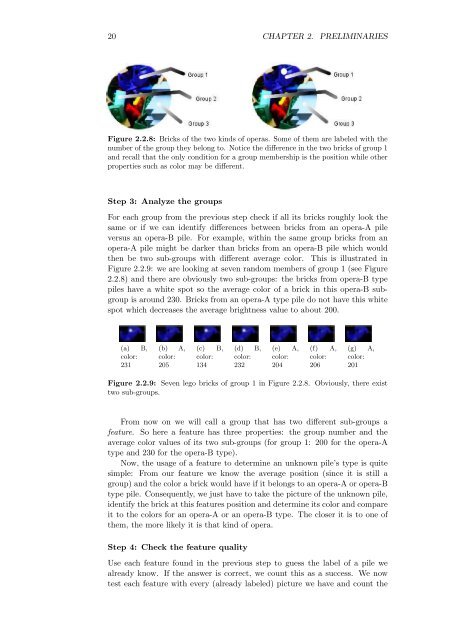New Statistical Algorithms for the Analysis of Mass - FU Berlin, FB MI ...
New Statistical Algorithms for the Analysis of Mass - FU Berlin, FB MI ...
New Statistical Algorithms for the Analysis of Mass - FU Berlin, FB MI ...
You also want an ePaper? Increase the reach of your titles
YUMPU automatically turns print PDFs into web optimized ePapers that Google loves.
20 CHAPTER 2. PRELI<strong>MI</strong>NARIES<br />
Figure 2.2.8: Bricks <strong>of</strong> <strong>the</strong> two kinds <strong>of</strong> operas. Some <strong>of</strong> <strong>the</strong>m are labeled with <strong>the</strong><br />
number <strong>of</strong> <strong>the</strong> group <strong>the</strong>y belong to. Notice <strong>the</strong> difference in <strong>the</strong> two bricks <strong>of</strong> group 1<br />
and recall that <strong>the</strong> only condition <strong>for</strong> a group membership is <strong>the</strong> position while o<strong>the</strong>r<br />
properties such as color may be different.<br />
Step 3: Analyze <strong>the</strong> groups<br />
For each group from <strong>the</strong> previous step check if all its bricks roughly look <strong>the</strong><br />
same or if we can identify differences between bricks from an opera-A pile<br />
versus an opera-B pile. For example, within <strong>the</strong> same group bricks from an<br />
opera-A pile might be darker than bricks from an opera-B pile which would<br />
<strong>the</strong>n be two sub-groups with different average color. This is illustrated in<br />
Figure 2.2.9: we are looking at seven random members <strong>of</strong> group 1 (see Figure<br />
2.2.8) and <strong>the</strong>re are obviously two sub-groups: <strong>the</strong> bricks from opera-B type<br />
piles have a white spot so <strong>the</strong> average color <strong>of</strong> a brick in this opera-B subgroup<br />
is around 230. Bricks from an opera-A type pile do not have this white<br />
spot which decreases <strong>the</strong> average brightness value to about 200.<br />
(a) B,<br />
color:<br />
231<br />
(b) A,<br />
color:<br />
205<br />
(c) B,<br />
color:<br />
134<br />
(d) B,<br />
color:<br />
232<br />
(e) A,<br />
color:<br />
204<br />
(f) A,<br />
color:<br />
206<br />
(g) A,<br />
color:<br />
201<br />
Figure 2.2.9: Seven lego bricks <strong>of</strong> group 1 in Figure 2.2.8. Obviously, <strong>the</strong>re exist<br />
two sub-groups.<br />
From now on we will call a group that has two different sub-groups a<br />
feature. So here a feature has three properties: <strong>the</strong> group number and <strong>the</strong><br />
average color values <strong>of</strong> its two sub-groups (<strong>for</strong> group 1: 200 <strong>for</strong> <strong>the</strong> opera-A<br />
type and 230 <strong>for</strong> <strong>the</strong> opera-B type).<br />
Now, <strong>the</strong> usage <strong>of</strong> a feature to determine an unknown pile’s type is quite<br />
simple: From our feature we know <strong>the</strong> average position (since it is still a<br />
group) and <strong>the</strong> color a brick would have if it belongs to an opera-A or opera-B<br />
type pile. Consequently, we just have to take <strong>the</strong> picture <strong>of</strong> <strong>the</strong> unknown pile,<br />
identify <strong>the</strong> brick at this features position and determine its color and compare<br />
it to <strong>the</strong> colors <strong>for</strong> an opera-A or an opera-B type. The closer it is to one <strong>of</strong><br />
<strong>the</strong>m, <strong>the</strong> more likely it is that kind <strong>of</strong> opera.<br />
Step 4: Check <strong>the</strong> feature quality<br />
Use each feature found in <strong>the</strong> previous step to guess <strong>the</strong> label <strong>of</strong> a pile we<br />
already know. If <strong>the</strong> answer is correct, we count this as a success. We now<br />
test each feature with every (already labeled) picture we have and count <strong>the</strong>









